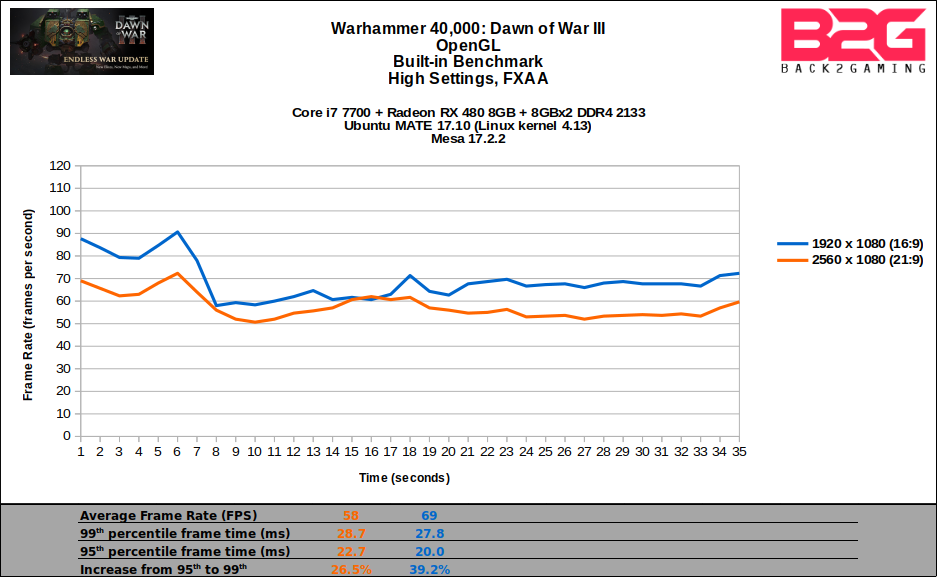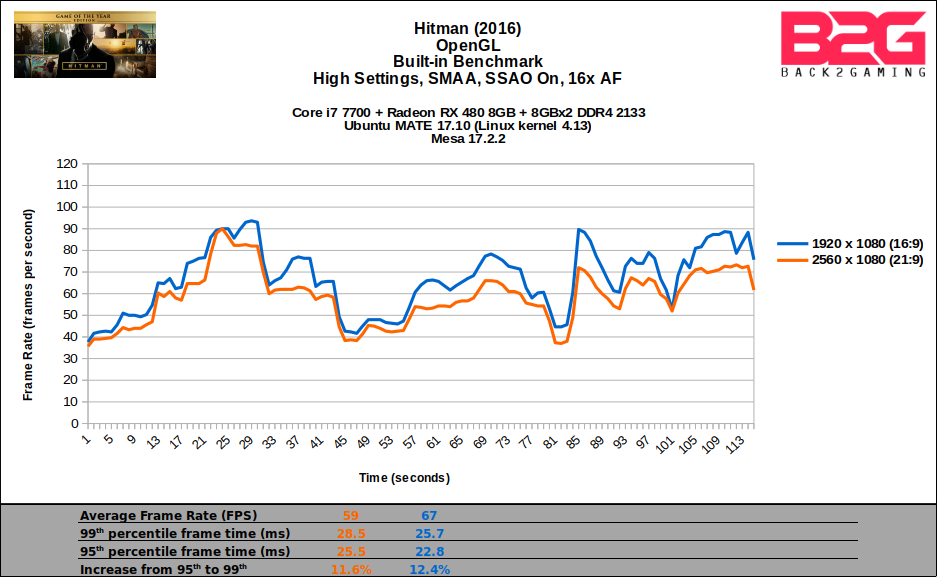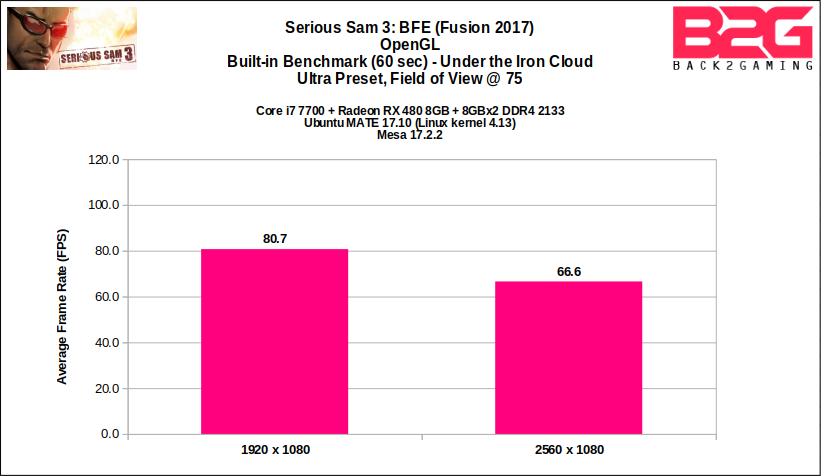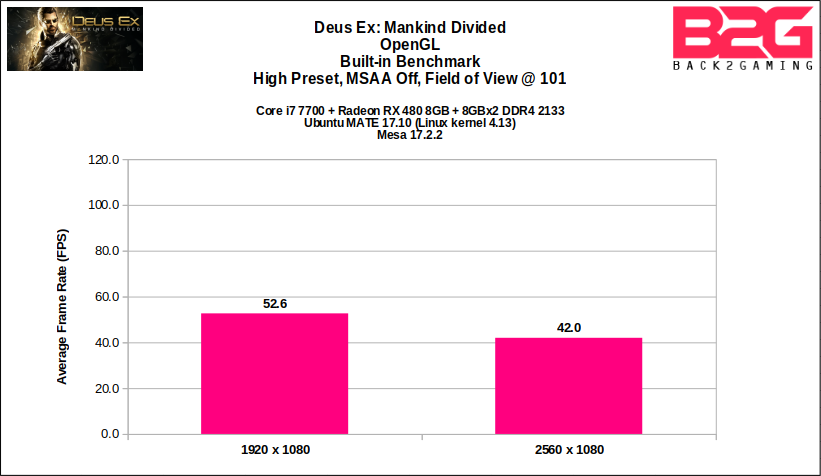One year and 4 months have already passed since AMD released the Radeon RX 480. Our testing results and those from other reputable online publications have already shown its impressive value for playing games at 1080p using a monitor with variable refresh rate. Affordable FreeSync monitors such as LG 23MP68VQ and AOC Agon G2460PF give Radeon RX 480 an advantage over the GeForce GTX 1060. There is also Vulkan that enabled Radeon RX 480 to surpass GeForce GTX 1060 in Doom [1][2]. However, almost all of the information about the Radeon RX 480 available on well-known online publications are based on the performance using AMD’s Crimson driver. Majority of PC gamers are probably not aware that RX 480 and other Radeon GPU’s can run games without installing GPU drivers made by AMD.
 Mesa is an open-source implementation of OpenGL and Vulkan [3]. Game developers, hardware vendors, and community of programmers contribute to the development of Mesa. We learned of its use in gaming from Phoronix and have found their gaming results interesting. Here at Back2Gaming, we don’t just read about stuff, we actually do them if resources are available. So, read on to find out how Radeon RX 480 performs even without AMD’s proprietary driver.
Mesa is an open-source implementation of OpenGL and Vulkan [3]. Game developers, hardware vendors, and community of programmers contribute to the development of Mesa. We learned of its use in gaming from Phoronix and have found their gaming results interesting. Here at Back2Gaming, we don’t just read about stuff, we actually do them if resources are available. So, read on to find out how Radeon RX 480 performs even without AMD’s proprietary driver.
How We Tested
We tested games with built-in benchmark tools to measure performance. To make the test results relevant for gamers using mainstream GPU’s, the games we tested are Warhammer 40,000: Dawn of War III, HITMAN, Deus Ex: Mankind Divided, and Serious Sam 3: BFE (Fusion 2017). Here is the test system we used and everything is running at stock speed.
Processor – Intel Core i7 7700 3.6 – 4.2 GHz
Graphics Card – ASUS ROG Strix RX 480 8GB
Motherboard – Gigabyte Z170N-Gaming 5 (rev 1.1)
Memory – G. Skill Trident Z 8GBx2 DDR4 3200 @ 2,133 MHz
Operating System – Ubuntu MATE 17.10
GPU Driver – Mesa 17.2.2
OS Drive – OCZ Trion 150 240GB
Secondary Drive – Apacer AS510S 256GB
Monitor – LG 29UM58 (2560 x 1080, 60 Hz, IPS)
As usual, the test results are the average of 3 benchmark runs. There are 4 benchmark runs but the 1st one is used to heat up the GPU and is not included in the averaging.
Test Results
The built-in benchmark tool of Warhammer 40,000: Dawn of War III depicts real-world game play so the performance numbers you see in the graph will probably be the same with what you will get when playing the game. RX 480 delivers an impressive performance here even when running only in OpenGL mode.
 HITMAN’s built-in benchmark tool does not depict real-world game play but it is demanding enough to give an idea how a system would perform. We played the Prologue Mission and have observed the frame rate to be above 50 FPS when running the game at 2560 x 1080 resolution using High settings with SMAA.
HITMAN’s built-in benchmark tool does not depict real-world game play but it is demanding enough to give an idea how a system would perform. We played the Prologue Mission and have observed the frame rate to be above 50 FPS when running the game at 2560 x 1080 resolution using High settings with SMAA.
 RX 480 delivers impressive performance in Serious Sam 3: BFE given that Ultra preset automatically enables 4x MSAA which is a performance killer. If you have a 1080p monitor with 144-Hz refresh rate and wants to reach 100+ FPS, you can manually disable 4x MSAA or just switch to High preset.
RX 480 delivers impressive performance in Serious Sam 3: BFE given that Ultra preset automatically enables 4x MSAA which is a performance killer. If you have a 1080p monitor with 144-Hz refresh rate and wants to reach 100+ FPS, you can manually disable 4x MSAA or just switch to High preset.
 Deus Ex: Mankind Divided runs well on RX 480 using High preset. If you want 1080p @ 60 FPS without having to resort to Medium preset, try these tweaked settings.
Deus Ex: Mankind Divided runs well on RX 480 using High preset. If you want 1080p @ 60 FPS without having to resort to Medium preset, try these tweaked settings.
 As bonus, we also made a video of DiRT Rally running the built-in benchmark tool. One benchmark run takes about 3 minutes and 25 seconds. Time is a limited resource so, we are settling for a benchmark video for now. Run the video in at least 720p full-screen mode to clearly see the results at the end of the benchmark. Take note that the performance numbers in the video will be slightly lower due to the performance penalty of OBS (Open Broadcaster Software). Without video recording, RX 480 can deliver an average frame rate of 100 FPS in DiRT Rally running at 2560 x 1080 resolution using High preset with 4x MSAA. DiRT Rally is also perfect for 1080p 144-Hz gaming monitors.
As bonus, we also made a video of DiRT Rally running the built-in benchmark tool. One benchmark run takes about 3 minutes and 25 seconds. Time is a limited resource so, we are settling for a benchmark video for now. Run the video in at least 720p full-screen mode to clearly see the results at the end of the benchmark. Take note that the performance numbers in the video will be slightly lower due to the performance penalty of OBS (Open Broadcaster Software). Without video recording, RX 480 can deliver an average frame rate of 100 FPS in DiRT Rally running at 2560 x 1080 resolution using High preset with 4x MSAA. DiRT Rally is also perfect for 1080p 144-Hz gaming monitors.
Closing Thoughts
The development of Mesa started in August 1993 and it’s really good to see how far it has progressed. Playing the latest games used to be tied to having to install a driver from the GPU vendor. Now, gamers have a choice and playing PC games on Linux is not limited anymore to using NVIDIA GeForce GPU’s. Though we have seen impressive results in our testing, using Mesa for Radeon GPU’s still has a long way to go. Some games don’t support Mesa upon release and gamers have to wait for game patches or newer versions of Mesa.
We are still not done yet with testing RX 480 using Mesa. Vulkan game benchmarks using RX 480 will be published hopefully before this week ends.
Follow us on Facebook and Twitter and subscribe to our YouTube channel if you want to know more about Mesa gaming performance and playing games on Linux.


